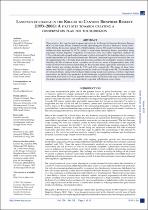 ResearchSpace
ResearchSpace
Land cover change in the Kruger to Canyons Biosphere Reserve (1993-2006): a first step towards a conservation plan for the subregion
JavaScript is disabled for your browser. Some features of this site may not work without it.
- ResearchSpace
- →
- Research Publications/Outputs
- →
- Journal Articles
- →
- View Item
| dc.contributor.author |
Coetzer, KL

|
|
| dc.contributor.author |
Erasmus, BFN

|
|
| dc.contributor.author |
Witkowski, ETF

|
|
| dc.contributor.author |
Bachoo, AK

|
|
| dc.date.accessioned | 2010-09-08T16:10:00Z | |
| dc.date.available | 2010-09-08T16:10:00Z | |
| dc.date.issued | 2010-07 | |
| dc.identifier.citation | Coetzer, KL, Erasmus, BFN, Witkowski, ETF and Bachoo, AK. 2010. Land cover change in the Kruger to Canyons Biosphere Reserve (1993-2006): a first step towards a conservation plan for the subregion. South African Journal of Science, Vol. 106 (7/8), pp 1-10 | en |
| dc.identifier.issn | 0038-2353 | |
| dc.identifier.uri | http://hdl.handle.net/10204/4336 | |
| dc.description | Copyright: 2010 Academy of Science of South Africa | en |
| dc.description.abstract | This paper is a first step towards a conservation plan for the Kruger to Canyons Biosphere Reserve (K2C) on the South African Central Lowveld, quantifying the historical land-cover trends (1993-2006). During the analysis period, 36% of the biosphere reserve (BR) underwent land-cover change. Settlement areas increased by 39.7%, mainly in rural areas, becoming denser, particularly along roadways. Human-Impacted Vegetation increased by 6.8% and Intact Vegetation declined by 7.3%, predominantly around settlement areas, which is testament to the interdependency between rural communities and the local environment. However, settlement expansion exceeded the rate of rangeland growth; in the long term, this may raise questions for sustainable resource extraction. Similarly, the block losses of intact vegetation are of concern; issues of fragmentation arise, with knock-on effects for ecosystem functioning. In the economic sector, agriculture increased by 51.9%, while forestry and mining declined by 7.1% and 6.3%, respectively. The future of these three sectors may also have significant repercussions for land-cover change in the BR. The identification of historical drivers, along with the chance that existing trends may continue, will have important implications for biodiversity protection in this landscape. Applied within a conservation-planning framework, these land-cover data, together with economic and biodiversity data, will help reconcile the spatial requirements of socio-economic development with those of conservation | en |
| dc.language.iso | en | en |
| dc.publisher | Academy of Science of South Africa | en |
| dc.subject | Lowveld areas | en |
| dc.subject | Landscape changes | en |
| dc.subject | Biosphere reserves | en |
| dc.subject | Biodiversity conservation | en |
| dc.subject | Land use | en |
| dc.subject | Rural geography | en |
| dc.title | Land cover change in the Kruger to Canyons Biosphere Reserve (1993-2006): a first step towards a conservation plan for the subregion | en |
| dc.type | Article | en |
| dc.identifier.apacitation | Coetzer, K., Erasmus, B., Witkowski, E., & Bachoo, A. (2010). Land cover change in the Kruger to Canyons Biosphere Reserve (1993-2006): a first step towards a conservation plan for the subregion. http://hdl.handle.net/10204/4336 | en_ZA |
| dc.identifier.chicagocitation | Coetzer, KL, BFN Erasmus, ETF Witkowski, and AK Bachoo "Land cover change in the Kruger to Canyons Biosphere Reserve (1993-2006): a first step towards a conservation plan for the subregion." (2010) http://hdl.handle.net/10204/4336 | en_ZA |
| dc.identifier.vancouvercitation | Coetzer K, Erasmus B, Witkowski E, Bachoo A. Land cover change in the Kruger to Canyons Biosphere Reserve (1993-2006): a first step towards a conservation plan for the subregion. 2010; http://hdl.handle.net/10204/4336. | en_ZA |
| dc.identifier.ris | TY - Article AU - Coetzer, KL AU - Erasmus, BFN AU - Witkowski, ETF AU - Bachoo, AK AB - This paper is a first step towards a conservation plan for the Kruger to Canyons Biosphere Reserve (K2C) on the South African Central Lowveld, quantifying the historical land-cover trends (1993-2006). During the analysis period, 36% of the biosphere reserve (BR) underwent land-cover change. Settlement areas increased by 39.7%, mainly in rural areas, becoming denser, particularly along roadways. Human-Impacted Vegetation increased by 6.8% and Intact Vegetation declined by 7.3%, predominantly around settlement areas, which is testament to the interdependency between rural communities and the local environment. However, settlement expansion exceeded the rate of rangeland growth; in the long term, this may raise questions for sustainable resource extraction. Similarly, the block losses of intact vegetation are of concern; issues of fragmentation arise, with knock-on effects for ecosystem functioning. In the economic sector, agriculture increased by 51.9%, while forestry and mining declined by 7.1% and 6.3%, respectively. The future of these three sectors may also have significant repercussions for land-cover change in the BR. The identification of historical drivers, along with the chance that existing trends may continue, will have important implications for biodiversity protection in this landscape. Applied within a conservation-planning framework, these land-cover data, together with economic and biodiversity data, will help reconcile the spatial requirements of socio-economic development with those of conservation DA - 2010-07 DB - ResearchSpace DP - CSIR KW - Lowveld areas KW - Landscape changes KW - Biosphere reserves KW - Biodiversity conservation KW - Land use KW - Rural geography LK - https://researchspace.csir.co.za PY - 2010 SM - 0038-2353 T1 - Land cover change in the Kruger to Canyons Biosphere Reserve (1993-2006): a first step towards a conservation plan for the subregion TI - Land cover change in the Kruger to Canyons Biosphere Reserve (1993-2006): a first step towards a conservation plan for the subregion UR - http://hdl.handle.net/10204/4336 ER - | en_ZA |





